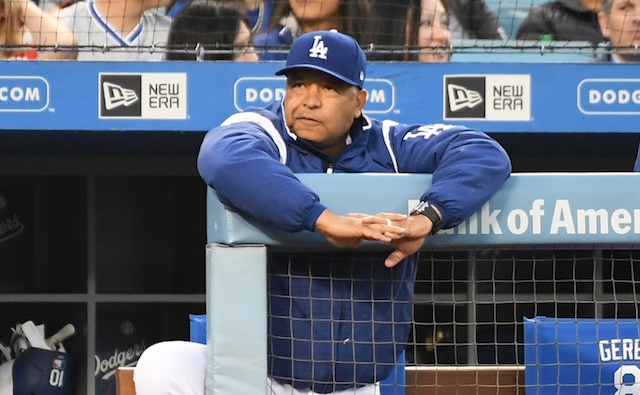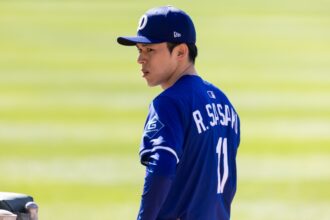With an injury-ravaged starting rotation heading into October, the Los Angeles Dodgers lineup was projected by many to need to be a driving force for the team in the postseason.
That included the bottom third of the unit continuing to help set the table for Shohei Ohtani and the top of the order. Among those responsible for keeping the line moving is Miguel Rojas, who is playing through a torn left adductor.
While Ohtani and Teoscar Hernández combined to drive in five of the Dodgers’ seven runs to erase both of Padres’ leads in Game 1 of the National League Division Series, they were aided by the trio of Gavin Lux, Tommy Edman and Rojas going 5-for-12.
Putting their top hitters in best position possible by doing their job is an approach Rojas and the rest of the Dodgers’ role players carry into the batter’s box.
“Especially knowing that we have our guys in the top of the lineup, our mentality is going to be grinding pitches out, having good at-bats, regardless of the results, of what the score is going to be during the whole game,” Rojas said prior to Game 2.
“That’s going to be 12 at-bats for us there, seven, eight and nine. And if we have good at-bats and we get a lot of pitches from the starting pitcher — like [Saturday], (Dylan) Cease was in trouble just because he threw a lot of pitches, a lot of 3-2 counts, and then Shohei can get a good pitch to hit up in the zone.
“I think it’s quality at-bat that you guys got to see from the bottom of the lineup, so the top of the lineup gets better pitches to hit and actually do damage because that’s what they’re here for.”
Rojas believes a change in mentality at the plate has been the most important thing for the Dodgers’ offense as a whole. As a team, the Dodgers take a lot of pride in their ability to control the strike zone and work the count, but the key is balancing that with being aggressive when getting hittable pitches.
This adjustment was sparked during a series against the Arizona Diamondbacks in which the Dodgers scored 22 runs over four games.
“That series in Arizona, we decided to be a little bit more aggressive. We as a team, as an offensive team, we thought every time we were behind in the games we kind of stopped and kind of shut it down and started getting at-bats and taking pitches and not being aggressive,” Rojas recalled.
“I think that put us kind of on our heels. And we decided not to be on our heels anymore. We want to be aggressive every single time. And knowing that we can always trust our eyes on pitches outside of the zone. I think our team controls the zone really well, but sometimes we try to control the zone way too much that we’re not aggressive.
“I feel like a day like [Game 1] kind of tells the whole story behind the aggression and kind of being on the attack every time because we’re down 3-0 but we’re never out of the game because we’re still aggressive. We’re not taking pitches, we’re not giving them free strikes and we’re ready to go. And they know it. If they throw the ball in the strike zone, it’s going to be a fight. It’s going to be a swing.
“With that being said, I feel like that’s the mentality of the bottom of the order too. We’re not going to be afraid of swinging the bat. But at the same time we know our abilities to kind of control the strike zone.”
Rojas and the bottom of the Dodgers lineup weren’t able to replicate that success in Game 2, which was a blowout loss that tied the NLDS as it shifts to Petco Park.
Miguel Rojas’ resurgence in 2024 for the Dodgers
Heading into this season, Rojas was not expected to have an everyday role. However, several factors contributed to more opportunities for the veteran, and he eventually became the Dodgers’ starting shortstop.
Rojas rewarded the team’s confidence with the most consistent season of his career.
“I think physically I work a lot to put my swing in a good position. I feel like this is the season that I’ve been the most consistent out of my 11 years in the big leagues. I’ve got to give credit to the hitting coaches staying on top of me and finding things that helps me,” Rojas said.
“And the mental side of it, knowing that I was going to play a part role at the beginning of the year, I was taking every at-bat like it was my postseason. And then that leading to when I got the opportunity to play every day and I know I was going to receive more at-bats and more opportunities, I feel like my swing was always in a good place and my mind was ready to actually take on the challenge.
“And my mentality was I never want the team to feel that Mookie (Betts) was absent. I was happy that I had the year that I had.”
Have you subscribed to the Dodger Blue YouTube channel? Be sure to ring the notification bell to watch player interviews, participate in shows and giveaways, and stay up to date on all Dodgers news and rumors!







